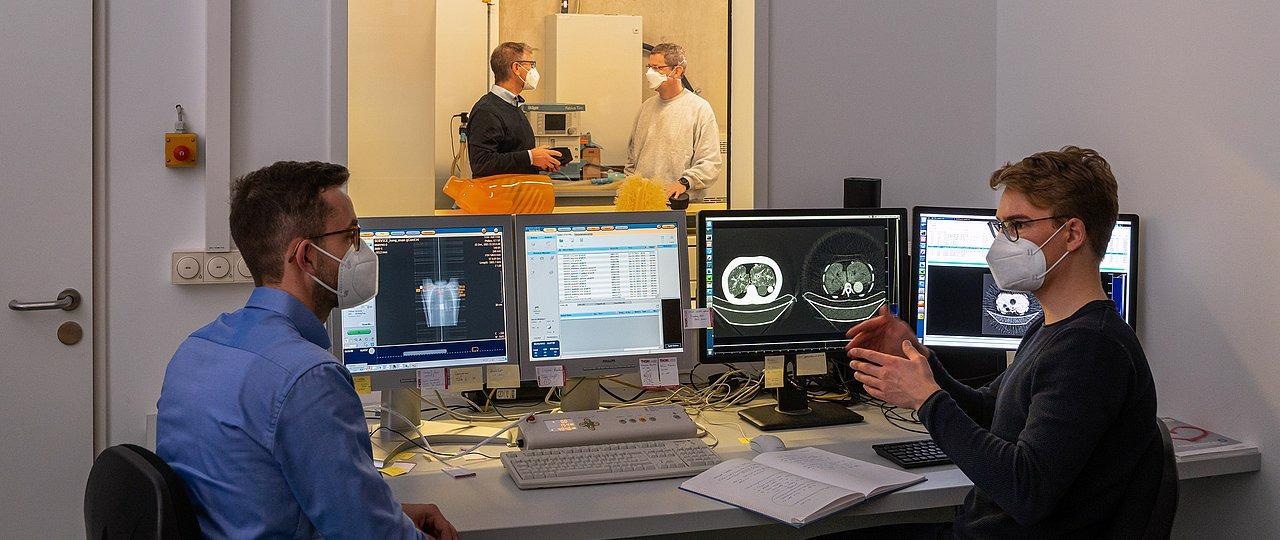The dark-field X-ray technology has been implemented into a CT scanner appropriate for clinical usage for the first time by a team of researchers from the Technical University of Munich (TUM). Dark-field imaging adds to the information offered by conventional X-ray imaging. It is now feasible to create 3D dark-field X-ray images using the new prototype.
 Prof. Dr. Franz Pfeiffer (back, left), Professor for Biomedical Physics, and his team have developed a prototype of a clinical CT scanner which combines dark-field and conventional X-ray technology (back right: Dr. Thomas Koehler, front left: Clemens Schmid, front right: Manuel Viermetz). Image Credit: Astrid Eckert / Technical University of Munich.
Prof. Dr. Franz Pfeiffer (back, left), Professor for Biomedical Physics, and his team have developed a prototype of a clinical CT scanner which combines dark-field and conventional X-ray technology (back right: Dr. Thomas Koehler, front left: Clemens Schmid, front right: Manuel Viermetz). Image Credit: Astrid Eckert / Technical University of Munich.
One of the most essential clinical technologies for precise and quick diagnosis is computed tomography (CT). Three-dimensional representations of the patient are created by merging numerous X-ray images.
Additional information on small tissue features, particularly in the lung, is now available—thanks to dark-field imaging. Technical issues have prohibited the incorporation of this new technology into clinical CT scanners for patient examinations until now.
A group of researchers, led by Franz Pfeiffer, Professor of Biomedical Physics and Director of TUM’s Munich Institute of Biomedical Engineering, has created a CT scanner that incorporates both X-ray technologies.
For the first time, we showed that dark-field X-ray technology can also be integrated into a clinical CT scanner. Although this technology is in its early stages, pre-clinical studies with mice have demonstrated clear benefits from dark-field CT scans, especially for capturing images of lung tissue.
Franz Pfeiffer, Director, Munich Institute of Biomedical Engineering, Technical University of Munich
Franz Pfeiffer led the study.
The new CT prototype has already been tested using a thorax phantom, a replica of a human upper body, and is large enough to be utilized with actual patients.
Conventional X-ray Imaging
The X-rays are weakened by the intervening tissue in traditional X-ray equipment as they travel from the source to the detector. This effect is utilized to generate images based on the different degrees of attenuation associated with various tissue types and structures. This is why X-ray images of bones and similar structures, which have a larger attenuating effect, seem white, but images of more transparent tissue types, such as the lung, appear darker.
Dark-Field X-ray Imaging
Dark-field imaging, on the other hand, makes use of the X-rays’ small-angle scattering. X-rays are scattered when they meet with materials of varying densities, such as the interface between lung tissue and air. The examination of this scattering effect provides extra information about extremely minute tissue structure that would otherwise be unavailable from typical X-ray imaging.
Grating Technology for Dark-Field Imaging
A set of three optical gratings is required to identify the scattering of X-ray radiation. They sit between the X-ray source and the detector. When X-rays flow through these gratings, they form a distinctive pattern at the detector. This distinctive pattern is modified when a sample or person is placed in the beam path. The structure of the sample or the person's tissue is then analyzed using these deviations.
New Hardware and Software for Dark-Field CT
The dark-field technique in a human-size CT scanner presents a number of technological problems. To date, this has limited the size of dark-field CT equipment to a fraction of what is required for human patients. In addition to the size, the scan unit’s quick rotation poses a unique set of challenges for the technological design.
The gantry, or scanning device, of CT scanners spins at extremely high speeds. This creates vibrations in the device’s interior, which disrupts the highly calibrated components. The team was able to use these vibrations to execute the essential shift between the gratings, required for dark-field imaging, after a thorough investigation of them. Researchers created new algorithms based on reference scans to assess the scans and filter out the vibration effects.
Additional Information for Clinical Diagnostics
With the dark-field CT prototype, we can capture conventional and dark-field X-ray images in a single scan. This yields additional information that could be used in the future not only to diagnose lung diseases but also to differentiate between various types of kidney stones and tissue deposits.
Manuel Viermetz, Study Co-First Author, Department of Physics, Munich Institute of Biomedical Engineering, Technical University of Munich
The researchers seek to improve the dark-field CT prototype and prepare for the first scans of human patients as the next stage.
Journal Reference:
Viermetz, M., et al. (2022) Dark-field computed tomography reaches the human scale. Proceedings of the National Academy of Sciences. doi.org/10.1073/pnas.2118799119.